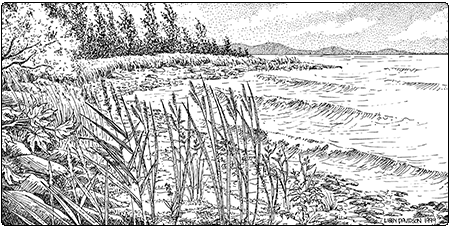Ecology and Physical Setting
Lakeshore Grassland is a rare community type in Vermont, with known occurrences only along the shores of Lake Champlain and Lake Memphremagog. This community occurs on gently sloping shorelines of gravel, cobble, and shale. These grasslands are generally only 25 to 50 feet wide but may extend for several thousand feet along the shoreline. This community likely occurs along the shores of other lakes in Vermont, but these examples are probably very narrow, as the width of the community is tied to seasonal lake level fluctuations.
Ice scouring during the winter and spring, flooding that may last into the early summer in wet years, and breaking waves are all factors responsible for maintaining this community as an open grassland. On their upper margins, Lakeshore Grasslands may be bordered by Lakeside Floodplain Forests or upland forest communities. The grassland is above the usual summer lake levels, although breaking waves keep the soils moist. Groundwater seepage may provide a constant source of moisture to this community at some sites. Fine mineral soils and organic matter accumulate in the gaps between cobbles and shale shingles, providing a substrate for vascular plants and bryophytes.

Lakeshore Grassland may intergrade with Lake Shale or Cobble Beach, an upland community. Substrate type, shoreline stability, elevation, and the amount of groundwater seepage distinguish these two communities.
Vegetation
This open community is dominated by grasses, sedges, and herbs that typically cover at least 50 percent of the ground and grow in the finer substrate between the cobble and shale. Characteristic plants are freshwater cordgrass, greenish sedge, silverweed, fringed loosestrife, shining ladies’ tresses, and wild mint. Although seldom abundant, the presence of variegated scouring-rush in some lakeshore grasslands is an indication of calcium-rich substrate or seepage. Non-native, invasive species including flowering rush and purple loosestrife may be common at some sites.
Mosses are common on the organic substrate between cobbles and shale pieces. Hypnum lindbergii and Ptychostomum pseudotriquetrum, both of which generally occur in calcium-rich habitats, are common mosses.
Woody vegetation is very sparse in the grassland community. It consists of scattered shrubs of willow and red-osier dogwood, with seedlings and saplings of silver maple, green ash, and cottonwood. Trees of the latter three species are common landward of the grassland community.
Wildlife Habitat
Northern leopard frogs may be common in Lakeshore Grasslands, breeding along the vegetated lake shores. Minks and raccoons are both common in these shorelines, where they hunt along the water’s edge. Great blue herons and green herons stalk the vegetated shoreline hunting for frogs and small fish. Tule bluet, a beautiful blue-striped damselfly, prefers densely vegetated lake margins and is most common along Lake Champlain. Native and non-native snails can be common on the algae-covered cobble within the spray of breaking waves.
Related Communities
- Lake Shale or Cobble Beach is an upland community subject to wave action, flooding, and ice scouring like the Lakeshore Grassland Community, but the substrate tends to be hot and dry in summer. Showy tick-trefoil and Canada anemone are common plants in this sparsely vegetated community.
- Rivershore Grassland is found along rivers and is also kept open by ice scour and flooding, but the duration of spring flooding is typically shorter than in Lakeshore Grasslands. The substrate is less stable and may shift in years with high river flow. Grasses and herbs dominate.
Conservation Status and Management Considerations
Threats to Lakeshore Grasslands include shoreline development, loss of forested buffers, trampling, beach raking, and alteration of groundwater discharge. Several good examples of this community are protected on conserved land. Purple loosestrife is common in many lakeshore grasslands and poses a significant threat to their ecological integrity.
Distribution/Abundance 
A rare community type found on the shores of Lake Champlain and Lake Memphremagog. Similar communities are found along the Great Lakes and on some larger lakes of New England.
Characteristic Plants
Shrubs and Saplings
Occasional Species
Shining willow – Salix lucida
Slender willow – Salix petiolaris
Red-osier dogwood – Cornus sericea
Silver maple – Acer saccharinum
Green ash – Fraxinus pennsylvanica
Cottonwood – Populus deltoides
Herbs
Abundant Species
Freshwater cordgrass – Spartina pectinata
Greenish sedge – Carex viridula
Occasional to Locally Abundant Species
Silverweed – Argentina anserina
Fringed loosestrife – Lysimachia ciliata
Wild mint – Mentha arvensis
Northern bugleweed – Lycopus uniflorus
Variegated scouring-rush – Equisetum variegatum
Bluejoint grass – Calamagrostis canadensis
Tall meadow rue – Thalictrum pubescens
Rushes – Juncus spp.
Shining ladies’ tresses – Spiranthes lucida
Straw-colored flatsedge – Cyperus strigosus
Swamp milkweed – Asclepias incarnata
Non-native Invasive Plants
Purple loosestrife – Lythrum salicaria
Reed canary grass – Phalaris arundinacea
Flowering rush – Butomus umbellatus
Bryophytes
Occasional to Locally Abundant Species
Moss – Hypnum lindbergii
Moss – Ptychostomum pseudotriquetrum
Rare and Uncommon Plants
Greenish sedge – Carex viridula
Alpine rush – Juncus alpinoarticulatus
Obedience – Physostegia virginiana
Beach wormwood – Artemisia campestris ssp. caudata
Northern meadow rue – Thalictrum venulosum
Shining ladies’ tresses – Spiranthes lucida
Ontario aster – Symphyotrichum ontarionis
Smith’s bulrush – Schoenoplectiella smithii var. smithii
Virginia bugleweed – Lycopus virginicus
Redroot flatsedge – Cyperus erythrorhizos
Associated Animals
Northern leopard frog – Lithobates pipiens
Raccoon – Procyon lotor
Mink – Neovison vison
Great blue heron – Ardea herodias
Green heron – Butorides virescens
Spotted sandpiper – Actitis macularius
Mallard – Anas platyrhynchos
Meadow vole – Microtus pennsylvanicus
Tule bluet – Enallagma carunculatum
Macropis bee – Macropis nuda
Places to Visit
Campmeeting Point, Knight Point State Park, North Hero, Vermont Department of Forests, Parks, and Recreation (VDFPR)
Round Pond State Park, South Hero, VDFPR
Niquette Bay State Park, Colchester, VDFPR
Delta Park, Colchester, Winooski Valley Park District
